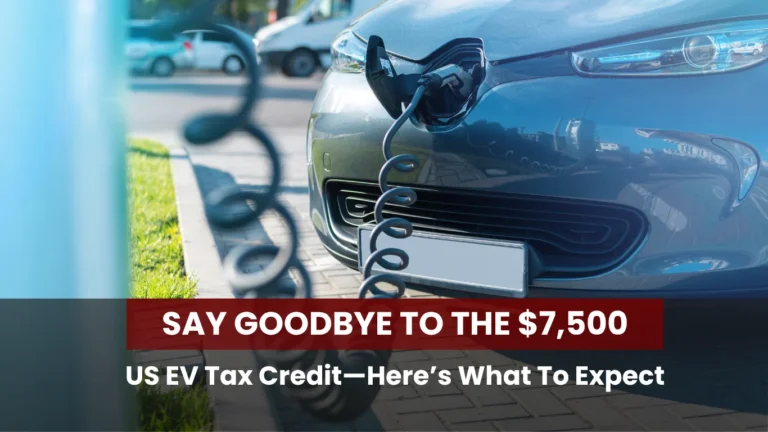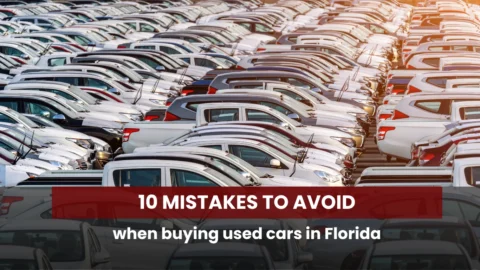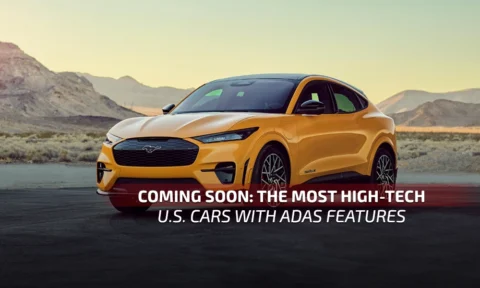If you’ve been following the electric vehicle (EV) space, you probably know that the $7,500 EV tax credits played a significant role in encouraging people to adopt EVs. But the $7,500 EV tax credit ended on September 30, 2025.
With the deadline for the EV tax credit expiration in 2025 passing, it marks a pivotal moment for consumers, automakers, and the environment. This essentially means that if you purchase an EV after September 30th, you will not be able to claim the $7,500 EV tax credit.
So, the question that needs to be asked is: will people continue to buy EVs when they know they will now have to bear an additional $7,500 financial burden, when EVs are not cheap in the first place?
Let’s explore.
What’s Changing: Key Impacts of the US EV Tax Credit Ending
1. No more $7,500 rebate for new EVs
The biggest headline is that the $7,500 EV tax credit ended as of October 1, 2025. That means if you purchase or lease a new EV now, you won’t be able to claim that credit in 2025 or in future years under current law.
2. Used EV credit also ends
It’s not just new EVs that are affected. The used EV tax credit ends in 2025 means purchasers of qualifying previously-owned EVs can no longer claim up to $4,000 after the expiration date. The IRS already updated its rules: you must acquire (or sign a binding contract / make payment) by September 30, 2025, to qualify for the tax credits.
3. Automakers are scrambling to adapt
With demand expected to collapse this month onwards, many automakers are reacting in real time. Reuters reports that EV sales could fall sharply without the incentive in place. Meanwhile, Tesla has already hiked lease prices in response to the removal of the credit. And Ford and GM have attempted a clever workaround: their financing arms have effectively paid the down payments to buy EVs into their retailers’ inventory before September 30 so that the $7,500 credit can indirectly benefit customers leasing their EVs.
4. Short-term bump, then cooling
In the weeks leading up to the expiry, EV demand surged as buyers rushed to buy before the credits vanished. But analysts now warn that without the $7,500 incentive, many prospective buyers will delay or cancel their plans, leading to a dip in EV adoption.
EV Credit Changes 2025: What Consumers Need to Know
As of 2025, several changes have been implemented regarding EV credits:
1. Income and Vehicle Price Caps
The new legislation introduces stricter income and vehicle price caps for EV credits, limiting eligibility to higher-income individuals and more expensive vehicles.
2. Credit Transferability
Consumers now have the option to transfer their EV credit to an eligible dealership, allowing for an immediate point-of-sale discount instead of waiting until tax filing.
3. Credit Phase-Outs
Certain EV models are no longer eligible for the credit due to sales caps, and the credit amount may phase out for manufacturers that have reached production thresholds.
Impact of EV Tax Credit Removal
1. Cost barrier reappears
That $7,500 offset made many EVs more competitive with gasoline cars. Without it, the upfront cost of purchasing an EV increases, potentially making them less accessible to a broader range of consumers. Hence, more consumers may go back to buying ICE vehicles.
2. Slower Adoption Rates
The EV tax credit has been a critical factor in accelerating EV adoption. Its removal may lead to a slowdown in the transition from internal combustion engine vehicles to electric vehicles.
3. Return on investment becomes longer
EVs already rely on lower fuel and maintenance costs to show savings over the years. Removing incentives makes driving them “pay off” over a longer duration, making it more challenging to convince buyers.
4. Used market loses support
The removal of the used EV tax credit end of 2025 dampens demand for the used EV segment too, especially for lower-income or budget-conscious buyers.
5. Disruption to auto industry forecasts
Automakers and consumers alike may experience uncertainty regarding the future of EV incentives and the overall direction of the electric vehicle market. Executives are reportedly bracing for EV sales to shrink to just 5% of total U.S. auto sales this month.
What Comes Next? What Does the Future of Electric Vehicle Incentives Look Like?
With the expiration of the federal EV tax credit, many are left wondering what incentives, if any, will replace it. Currently, there is no direct federal replacement for the EV tax credit. However, several alternative incentives and programs may help offset the costs of purchasing an electric vehicle. Here’s how the future is set to get interesting and uncertain:
1. State and local incentives may step up
Many states offer their own EV incentives, including rebates, tax credits, HOV lane perks, charging support programs, and exemptions from sales tax. These programs vary widely by state, so it’s essential to check with your local government or utility company to see what’s available in your area. These may become more important as federal support fades.
2. Automaker-driven incentives and leasing hacks
In response to the federal credit’s expiration, some automakers are introducing their own incentives to encourage EV purchases. As mentioned earlier, Ford and General Motors have developed programs to extend leasing incentives for several months, effectively maintaining consumer incentives through the end of 2025.
3. Utility Company Programs
Some utility companies provide incentives for EV owners, such as rebates for home charging equipment or reduced rates for electricity used to charge EVs during off-peak hours.
4. New deductions under “One Big Beautiful Bill”
That legislation (signed in 2025) doesn’t preserve the EV credit itself, but it introduces other auto-related tax provisions, like deductions for auto loan interest on U.S.-assembled cars.
5. Possibility of reinstated or revised incentives
Congress could bring new EV incentives after the tax credit ends. These programs could possibly be more targeted, limited, or conditional. At least that’s the hope among EV advocates.
New EV Incentives After Tax Credit
While the federal EV tax credit has expired, several new incentives and programs have been introduced to encourage electric vehicle adoption:
1. Enhanced Charging Infrastructure
The federal government has allocated funds to expand EV charging infrastructure across the country, making it more convenient for consumers to charge their vehicles.
2. Research and Development Grants
Grants are available for companies and institutions conducting research and development in EV technologies, aiming to drive innovation and reduce costs.
3. Workplace Charging Programs
Some employers are offering incentives for employees to purchase EVs, such as providing charging stations at the workplace or offering financial incentives.
How Should You React?
1. Planning to Buy?
If you were planning to buy, you should have already signed a binding contract and made a down payment by September 30 to claim the credit. If not, it’s best to wait for prices to settle down before buying.
2. Ask dealers about lease workaround deals
Some automakers are including incentives in leases via the credits they claimed earlier. Find out about these.
3. Revisit your EV cost calculations
Without the credit, run new projections on the total cost of EV ownership, payback period, and incentives in your state.
4. Watch for new incentives or legislation
The policy landscape will likely evolve. Stay informed about the developments in the EV space.
FAQ: Navigating the Post-Credit EV Landscape
Yes, if you signed a binding contract and made a payment on or before September 30, 2025, you may still be eligible for the credit, even if the vehicle is delivered after that date.
While the federal EV tax credit has expired, there are still some federal programs aimed at supporting EV adoption, such as grants for charging infrastructure and research and development.
State-level incentives vary widely. It’s recommended to visit your state’s energy or transportation department website or consult with local utility companies to learn about available programs.
Some automakers are introducing their own incentives to encourage EV purchases, such as leasing programs and rebates. It’s advisable to check with individual manufacturers for current offerings.
The removal of the credit may lead to higher upfront costs for EVs, potentially slowing adoption rates. However, increased competition and advancements in technology may help mitigate price increases over time.
Final Thoughts
The US EV tax credit ending is proving to be a major shift in the electric vehicle landscape. Removing up to $7,500 EV tax credit from new vehicle purchases and ending the used EV tax credit removes a major financial incentive that helped drive EV adoption. I’m sure the impact of EV tax credit removal will shake up the industry, consumer behavior, and state-level programs.
But this isn’t necessarily the end of incentives. Automakers are already innovating with lease structures, and future new EV incentives after the tax credit may emerge. For now, if you’re in the market for an EV, my advice would be to hold on for a while until you gain some clarity on where prices are likely to settle once the situation cools down.







